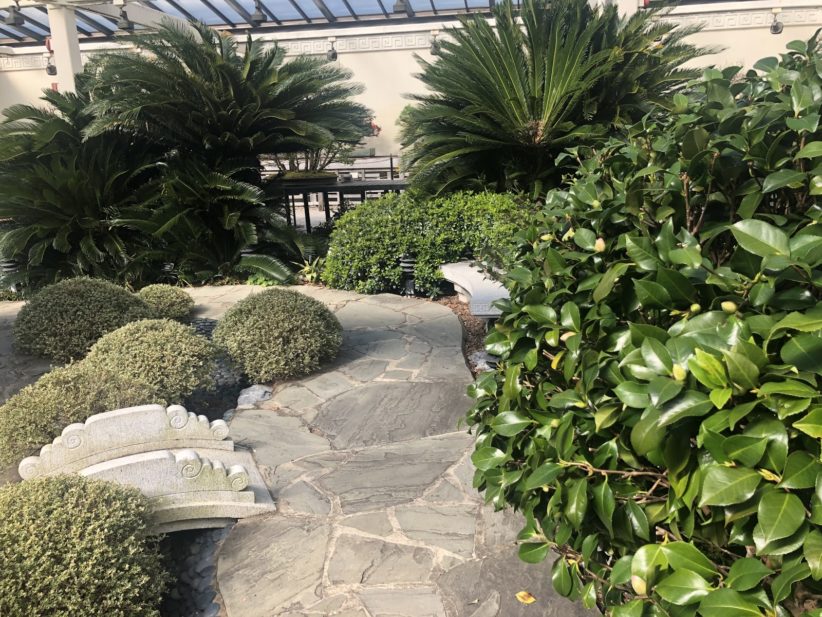As clocks move forward, many people search for ways to transition from the humdrum of winter into the spring. The National Arboretum is a sure bet to get everyone out of the winter blues and ready to embrace the beautiful springtime in Washington, D.C.
As Washington, D.C. prepares for the peak bloom of its well known cherry blossom trees in early April, the National Arboretum offers the most diverse selection of cherry trees in the region.
Congress established the Arboretum in 1927, aims to increase the aesthetic, environmental and economic importance of landscape and ornamental plants, according to a website for D.C. visitors. The attraction does so through gardens and exhibits, long-term botanical research and conservation of resources. The Arboretum is a 446-acre property open almost every day of the year.
On a day where the sun is shining bright, but the chill of winter is still very present, husband and wife Bill and Malinda Cecil have traveled to Washington D.C. from the Eastern Shore of Maryland on their day off to get a taste of springtime.
“We’ve actually never been here before, but we’ve always wanted to come. So today as it’s starting to brighten up, we thought there is no better way to spend our day,” says Malinda
As Bill walks around the National Bonsai & Penjing Museum, intently focused and snapping pictures he says, “I’m taking photos for our son who is a professional bonsai glass blower. So I thought ‘what better place is there to get sample photos than the National Bonsai Museum itself?'”
This public park is run with the help of both paid staff and over one hundred dedicated volunteers who are all more than ready to welcome springtime at the arboretum.
“This spring seems like it’s been a little late in coming this year. So the one thing that’s for sure is that we’re all very ready for springtime to come. But on the other hand it means a lot of work compressed in a very short period of time,” says Scott Aker, head of horticulture and education at the National Arboretum.
He says, “Plants do not observe daylight savings time. They run on their own schedule so we have to be prepared for whatever nature throws at us.”
What is the typical preparation process for this time of year at the Arboretum? “Right now, we have late winter pruning going on, we have clean up of perennial beds and cutting plants that were left over from last winter,” says Aker.
Although the national park is open all year long, the winter months are slower than others and tends to be a time of preparation for warmer months ahead. How many visitors? Aker says, “We’re starting to look at things like making sure our signs and display labels are in good shape for when we have our main rush of visitors.”
He says, “This time of year, our hope is that when spring arrives, it arrives. The worst thing is when we get several weeks of nice weather in March and then the last week of March we get a night that’s 12 or 13 degrees.”
The National Arboretum is home to world-famous collections – of azaleas, Bonsai and Penjing, dwarf conifers, perennial collections, Asian collections, Holly and Magnolia collections and much more.
Scott Aker elaborates on the diversity of plants that can be found in the research park. He says, “There is something in bloom every month of the year here. Right now we’re at peak bloom for things like our witch hazel, that naturally bloom during this time of year. Our Japanese apricot trees that look a lot like cherry trees are in full bloom right now.”
When is the most popular time of the year? “Our really heavy time here is the end of April, early May. We have a major plant sale the last weekend of April and that always brings a lot of traffic through here. It’s always full in the spring because people are coming back outside after being shut in all winter.”
“It seems like life starts in March. It’s really a time for renewal and a time to reset,” says Malinda Cecil.
Located 2.2 miles from the capital, the National Arboretum conducts research for a plethora of plants. Scott Aker says, “Because of our typography we have been blessed with a site where you wouldn’t even know that you’re so close to downtown or a major urban center. So it’s truly a get away. But deeper than that, we are a genetic resource for a wide variety of plants that breeders and the nursery industry use to bring better plants to people’s landscapes. So the real importance of the arboretum is that this is a place that allows people to have better plants in their own gardens and backyards.”
Aker says, “The Arboretum is doing more than providing plants to the city. It’s helping the entire country and the entire world. Everyone should know that.”
According to the Cecil family, the National Arboretum houses artwork that money could never buy. Malinda says, “This is some of the most beautiful artwork that you can’t buy. This is something you just have to experience.” This is a place that clears the heart mind and soul.







